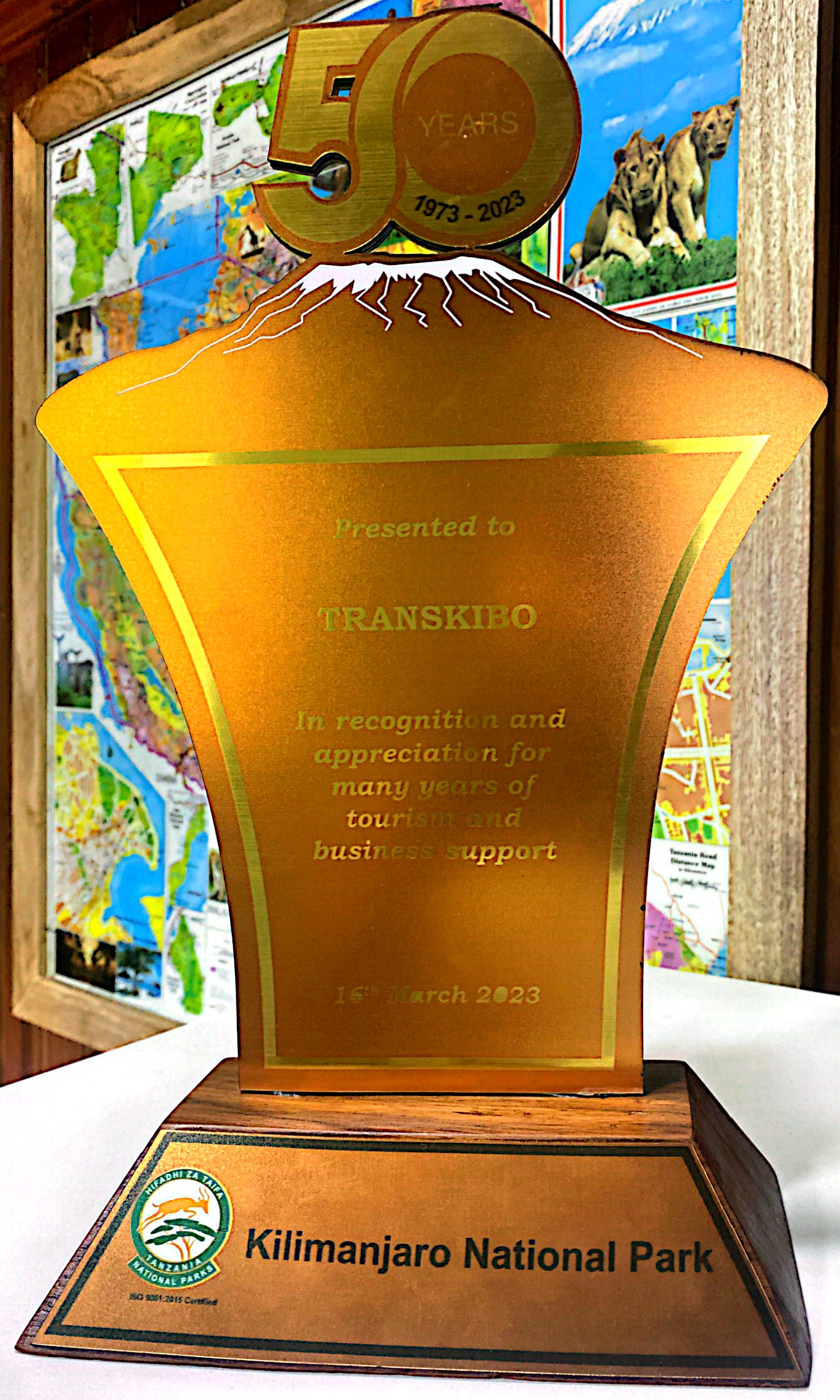The Big Five in Serengeti National Park
The Big Five defined by Transkibo travels in Tanzania National Park with the great experience: seeing these impressive and great animals;- lion, rhino, leopard, elephant and Cape buffalo – roaming freely in their own habitat is something you will never forget. You might wonder however, why those specific animals are part of the Big Five? Is a giraffe not large as well? Here is a factoid: the term ‘Big Five’ was coined by big game hunters and is not derived from the size of the animals. These animals proved to be the most difficult to hunt, mostly due to their ferocity when cornered. They are examples of charismatic megafauna, featuring prominently in popular culture, and are among the most famous of Africa’s large animals. The Big-game hunters referred the five most difficult animals in Africa to hunt on foot but is now more widely used by game viewing tourists and safari companies in Africa.
Great work that these Big Five found in the plains of Serengeti national park in Tanzania are now only ‘shot’ by camera. Transkibo travels with the best guides and trackers will help you to check the Big Five off your list. (And in the meantime let’s not forget that other wildlife – like giraffes or hippos – are just as exciting to spot.)
Lion
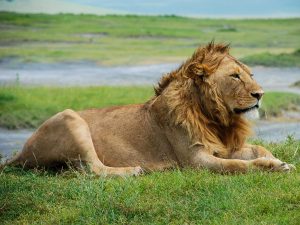
As King of the jungle in the African savannah: seeing a pride of lions in their own habitat will leave you with an indelible memory. We have some good news for you: the Serengeti is home to some incredibly large prides of lions and they are fairly easy to spot. Lions live in a pride because they’re very social animals. In a group, the females hunt more than the males, but most will happily scavenge if they get the chance, because their favorite activity is snoozing under a tree: something they like to do for about 20 hours a day!
African Leopard
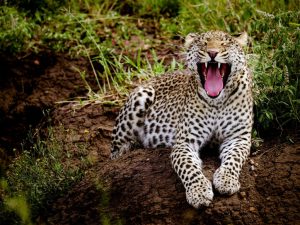
They walk with an elegant grace and have an amazing coat: the leopard, also known as ‘The Prince of Darkness’. This is the most shy and elusive one of the Big Five. Leopards are excellent at playing hide and seek: if they don’t want to be seen, they can be perfectly camouflaged. In the Serengeti, you will be most likely to spot a leopard resting on a tree branch. The large branches of the sausage tree are their favorite spot. So never forget to look up: a leopard might be enjoying his lunch high up in a tree, so lions and other predators don’t bother him.
African Buffalo
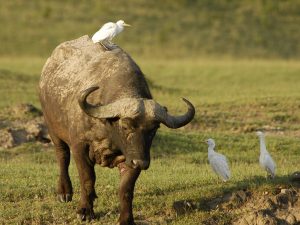
The African buffalo also known as the Cape buffalo (Syncerus caffer) is a large mammal of the African bovine family. They can be easily seen in protected areas and national parks such as the Ngorongoro Crater and the Serengeti. These large and robust bovines belong to the famous Big Five, being described by hunters as being extremely dangerous animals to approach when wounded. Some even claim, that up to 200 people are gored and killed each year by buffalos.
Not quite the lazy bush cow you might imagine: the buffalo is one of Africa’s most dangerous animals with very few predators. Lions might try to go for a calf, but are likely to pay the price later when an angry herd takes revenge. Buffalo needs to drink every day, so they are often found at a waterhole. Although they can be notoriously bad tempered, especially when they’re injured, their wise gaze – as once described by a novelist: ‘They look at you like you owe them money’ – makes them thrilling to see. In the Serengeti, buffalo come in very healthy numbers: there’s a good chance you’ll see herds with over 1,000 or more of these thrilling animals.
African elephant
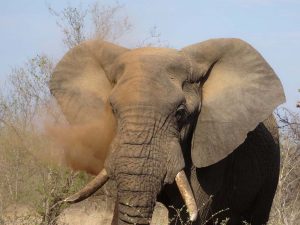
It’s the world’s largest land animal, and seeing one in its natural habitat is simply thrilling. In the Serengeti, these grey giants roam the plains and disappear into the woodlands. Female elephants live in close-knit clans and family bonds can last for 50 years. Males often leave the clan after 12 years to roam singly or form bachelor herds. Elephants frequently visit waterholes close to lodges. They are peaceful when left alone, but if an elephant feels threatened, get out of the way. Nothing scarier than being chased by an animal that weighs 7,000 kilos (imagine the weight of seven stacked cars) and trumpets loudly…
Black Rhino
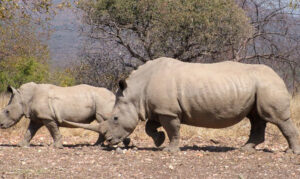
The rhino is a pre-historic heavyweight, weighing in at 2,500 kilos. There are two types of rhinos in Africa: the black and white rhino. As you might expect, the white rhino is not white, but grey like the others. The name ‘white’ was misinterpreted after early Dutch settlers used the word ‘wijd’ (wide), referring to its broad lips. Unfortunately, the rhino has a horn that’s worth more than its weight in gold. Over the past several decades, the rhino population in the Serengeti ecosystem has suffered greatly due to poaching: rhino numbers decreased from 1,000 to less than 70 individuals. The female rhino only gives birth every five years, making the rhino one of the most challenging animals to spot in Serengeti National Park, but with an experienced guide by your side, you might get lucky!
Other Tanzania Wildlife Animals
Giraffe
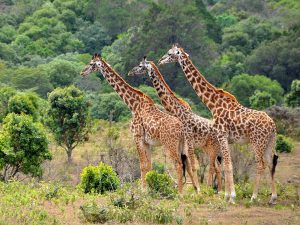
Being a Tanzania’s National Animal! Tanzania has chosen the graceful, intriguing giraffe (Giraffa camelopardalis) as its national animal. Standing an average of 20 feet tall, the giraffe is the tallest land mammal on earth. Giraffes are social animals.
Giraffes are very fascinating animals – graceful and mostly gentle. Whilst on safari in Tanzania you are likely to come across these giants. There are nine subspecies of giraffes and only one of them, the Maasai Giraffe, occurs in Tanzania. The different species distinguish themselves by their coats.
The giraffe got its name from the Arabic name “Zirapha” meaning the “fast walker”. In the 1600’s it became giraffe in English, derived from the French word girafe.
Giraffes are the tallest terrestrial animals in the world and males can reach a towering height of nearly 6 meters! They can weigh well over a ton, whereas females are just under. In the wild, giraffes can live up to 25 years. Their preferred habitat is savannah, grassland and open woodland and they are found in sub-Saharan Africa stretching all the way from Chad to South Africa.
Wildebeest or Gnu
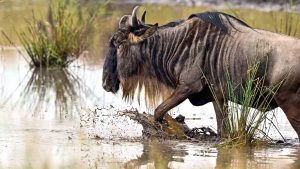
A wildebeest is a version of an antelope. They have horns whether they are male or female. While they are territorial, they are also known for being playful, energetic, and active. Of all the antelopes in Africa, the wildebeest population has grown from 250,000 alive in 1960, and 1.5 million as of 2020. In African countries, the animal known as gnu was given the nickname Wildebeest. In English, this translates to the wild beast. In England in 1823, a naturalist named William John Burchell was the world’s first to describe the Blue Wildebeest. The wildebeest’s scientific name was formed using two Greek words that help describe the animal’s physical appearance.
Being one of Africa’s top safari destinations. The wildlife game viewing is the best tour to do during your visit in Tanzania. All members of the Big Five (lion, leopard, elephant, rhino and buffalo) can be found in various Tanzanian parks and reserves, and all five are present in the Ngorongoro Crater and Serengeti National Park. Let Transkibo Travels Ltd be the first and best guide of Tanzania trip.






